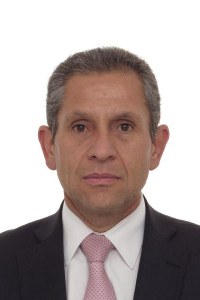Balantic, Zvone
University of Maribor, Faculty of Organizational Sciences, Kidriceva 55a, SI-4000, Kranj, Slovenia, e-mail: zvone.balantic@fov.uni-mb.si
Flezar, Matjaz
University Clinic for Pulmonary and Allergic Diseases Golnik, SI-4204, Golnik, Slovenia, e-mail: matjaz.flezar@klinika-golnik.si
ABSTRACT
Process of life is a composite of many physiological processes that are in dynamic equilibrium all the time. Feed-back control mechanisms are necessary to maintain that equilibrium as constant as possible. Life consists of interactive influences from our environment and our body systems and gas exchange is one of the most important physiological regulatory systems, responsible for life. The purpose of our work is to assess the level of pulmonary patients motivation to learn more about his disease and perhaps to induce his participation in the process of diagnostic procedures and treatment as a whole. Pulmonary function testing is a routine procedure for most of pulmonary patients and soon after the first visit at the doctor's office patient has to be sent to the pulmonary function laboratory where lung volumes, flows, transport of oxygen to the blood and other parameters are measured. During the time that he spends waiting in front of the laboratory door he will be able to participate in our interactive multimedia support presentation and learn about the procedures awaiting him in laboratory.
Interactive multimedia support presentation presents the principles of lung function testing in a manner that is understandable for a patient with average secondary school knowledge, describes anatomy and development of respiratory system during human life, physiological principles of breathing mechanics and gas exchange and also video presentation of a patient that goes through all the above mentioned procedures.
Keywords:
Multimedia, lung function testing, education, medical healthcare education systems.
INTRODUCTION
Patient and a doctor meet and communicate from the beginning of a process, called disease management. Their communication is changing nowadays because it became evident that a patient must became an active participant in a process of disease detection, treatment and follow-up. During that process many communisation obstacles intervene, the most important being lack of a doctor's time to explain the necessary parts of a process to a patient and a patient ignorance or lack of knowledge about the disease. Another problem is also the limited ability of the patient to understand the explanations given by health providers [1] particularly when these subjects are faced with repeated explanations through the working day, every day. In spite of correct information given by the doctor or other health worker, the amount and the way that it is understood varies greatly among the patients [2]. Lung function testing procedure is a very common
point when patient-doctor interaction meets. In order to perform the testing properly a patient's collaboration is necessary. Doctor should be the first person to explain the procedure to the patient and laboratory personnel is the last chain in that procedure. Informed consents are usually needed before the procedure itself; therefore the explanation of laboratory technician is one step too late – after the concent should be signed. Therefore our interactive multimedia support presentation fills the informational gap and helps the patient to ease the anticipation of foregoing events.
Our work was focused on a patients' perspective of anticipating lung function testing and also fulfil the expectations regarding proper patient's performance met by his doctor. For this purpose we used written information - brochures and posters that were hanging on a waiting room's wall. In spite of that we noticed a lack of compliance of a patient to either read or understand that information and a lot of teaching by the technician was necessary to perform the tests in a laboratory. Therefore the introduction of an interactive multimedia support presentation was a great advantage in a sense of a patient education and compliance during the testing procedures.
The overall outcome would include advantages from the patients' view and from the view of health care providers. Our interactive multimedia support presentation help primarily the patient and through his knowledge also a better communication with other health care providers, he meets during the process if lung function testing.
Our interactive multimedia support presentation has been realised and created with collaboration of health care professionals (doctors, laboratory personnel), engineering science specialists and patients that were involved in a project. The information that was inserted in our interactive multimedia support presentation had to be clear and understandable to all of them in order to be included in a final presentation [3, 4].
MATERIALS AND METHODS
Preparation of procedures
For our interactive multimedia support presentation work plan we created a workgroup of a doctor (chief of Respiratory function laboratory), engineering specialist, laboratory personnel and patients that went through all the procedures. The first step was to analyse the existing team work in a Respiratory Function Testing Laboratory of University Clinic for Pulmonary and Allergic Diseases Golnik (Slovenia). We followed the procedures and different examination by following real patients through the testing, their participation in examination and final meeting with the doctor in his office. Another focus was on analysis of patient – technician communication with particular emphasis on their communication pitfalls.
Knowledge data
The basically knowledge that is necessary for understanding the basic principles of our interactive multimedia support presentation is on the level of secondary school human biology knowledge. The scope of the further in - depth presentation of lung physiology beyond that reaches the knowledge of different types of education, for instance medical, laboratory personnel, engineering, computing, organisational, etc.
Extensive graphical and drawing support with as little as possible written text for explanation describes development of a human respiratory system from the first weeks after conception, to birth and through the growth in childhood and adolescence. As a second part of interactive multimedia support presentation mechanical models of breathing are described with emphasis on lung volumes and flows. Basic principles are advanced to description of breathing in certain diseases
that alter lung mechanics. Parts of a database are also tables with reference (normal) values of lung volumes and flows for a given subject.
Software integration
All the menus are hierarchic and follow the sequence of explanations of certain thematic menu. Simple explanation of thematic is followed by more detailed description of a physiological process and a particular theme ends up with most common pathological state of described process. The Microsoft® Office PowerPoint® 2003 menus with their flexibility offer all ergonomic advantages of modern electronic desktop tool. It allows enough support and creativity to support the needs of an advanced user.
Our interactive multimedia support presentation of human respiratory system [5] is designed to lead the reader through different levels of explanations without loosing the depth or hierarchy tree of the document as a whole. The second part integrates a video presentation that is also branched according to real patient pulmonary function testing procedure.
Microsoft® Office PowerPoint® 2003 package named »Package for CD« offers all the needed integration mentioned above.
Mathematical modulation
Mathematic modulation of human respiratory system is a part of scientific respiratory research in medicine and tries to simulate functioning of this system in health and disease. Electric and mechanic analogues of lungs and chest wall, mechanics and time constants of lung emptying upon exhalation and respiratory dynamics can be presented also as mechanical / electrical resistance-capacity model. This modulation will be particularly important to students and others that have extensive knowledge in a field of mechanic or electric sciences.
Second part of mathematical modulation is construction of Excell-based formulas that can be used to calculate a patient's normal (reference) values for lung volumes and flows – based on published sets of such equation.
RESULTS
Video presentation
Video presentation is a part of our interactive multimedia support presentation and reflects the true situation during the pulmonary function testing in pulmonary function laboratory. According to the set of diagnostic procedures, that was chosen by the patients' doctor, a patient can chose among them in our presentation.
Separate diagnostic procedures are named:
- ction to lung function testing
- Spirometry
- capacity
- etacholine bronchial provocation test
- Pletismography
- Ergospirometry
- h procedures
- inal consultation with the doctor
Video part of our interactive multimedia support presentation lasts for 18 minutes and can be accessed within the Microsoft® Office PowerPoint® 2003 software or via Microsoft® Windows Media Player®. AVI type of file can also be shown as a real
video on Pentium III processor based CPU's or higher. Video compression was achieved using video codec Mpeg4. All video part is composed of video, music and voice comments, doctor's introduction and scientific explanation.

Figure 1: Video clips from different lung function testing procedures.
Graphical presentation
Interactive multimedia support presentation's basic goal is to describe physiological processes during breathing as clear and simple as possible. Graphic presentations are therefore very illustrative and allow a better understanding of an underlying process. Diagrams, drawings, pictures and flow-charts were used to support the written explanation.

Figure 2: Communication windows with an animated graphics and textual explanations.
Simulations
Beside animated explanations, text and videos we included also advanced theoretical approach to understanding certain processes. In order to clarify those we included simulations that can be triggered on mouse click. In mechanical model of breathing, for example, volumes and flows are closely interrelated and therefore their understanding is better reviewed during dynamic animation (simulation).
 |
|
Figure 3: Example of mechanical simulation of lung volume changes. |
Integral presentation to the patient
Exactly like the video presentation itself we created all animations, text, simulations and other add-ins by using Microsoft® Office PowerPoint® 2003. At the final presentation workup we used the new option available to autorun all sets of applications. The CD package is self detected after insertion into CD unit with Autorun option installed. Main data file is called PDDS.ptt that includes links to other *.ptt files (theoretical data, graphics, videos, etc.). That file also includes contents page that leads e-reader through the application. It is always possible to chose a user-determined scope of underlying presentations depending on his particular interest and knowledge. He can either choose theoretical backgrounds or just video presentation of the diagnostic procedures, he is about to perform. On the other hand, he can find also the information that is requested as basics knowledge of a medical student, as well as new insights in pulmonary function research.

Figure 4: Graphical page of Microsoft® Office PowerPoint® 2003 application.
CONCLUSIONS
Interactive multimedia support presentation was first introduced in the environment where it was created – Respiratory Function Laboratory of University Clinic for Pulmonary and Allergic Diseases Golnik, Slovenia. We analysed a patients' view of such presentation compared to previously used information databases:
- ' explanation,
- g material and
- Posters.
All of these materials were part of routine workup before the introduction of our interactive multimedia support presentation. The result of a questionnaire that was comparing the success of these different types of approach was very much in favour of our interactive multimedia support presentation. On the other hand, laboratory personnel, that performs the testing, was very oriented very much in favour our presentation, since they had to spend less time with the patient explaining procedures to him.
The presentation was evaluated also among the doctors that refer their patients to lung function testing. One of the goals was to make a doctors' task regarding the testing explanation easier. The patient was aware of the procedures even before he discussed them with his doctor and was able to ask elaborate questions regarding the testing during their conversation. The amount of the information given by the doctor was less, yet more specific regarding patient's needs.
The overall result was that with a greater degree of satisfaction regarding the patients' view we were able to lesser the explanation procedure time of both referring doctor and laboratory personnel to perform lung function testing. A patient became a true subject (not just an object) in a process of lung function testing. Global consequence was to lessen the waiting times for lung function testing, since we were able to finish the whole procedure sooner and therefore test more patients in a working day.
The higher quality of patients' care and all the above mentioned benefits should be the reason to use our interactive multimedia support presentation in the waiting room of every laboratory that performs the lung function testing or outpatient's clinic that refers their patients to that kind of testing.
Lung function testing is the basic diagnostic procedure (beside chest X-ray) that is used in every patient with respiratory system disease. Regarding incidences of obstructive lung diseases in general population the target testing population is about 0.5% of general population. Application of our interactive multimedia support presentation is such proportions would significantly improve pulmonary patients' care in every population setting as a whole.
ACKNOWLEDGMENTS
Special thanks for technical help to PLIVA - pharmaceutical company.
REFERENCES
1. Balantic, Z.:
Papers relacionados














